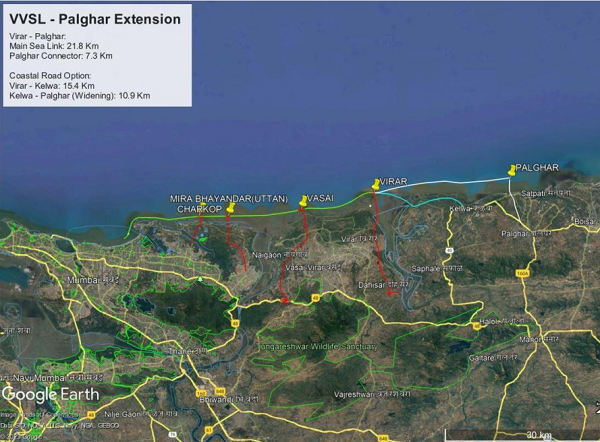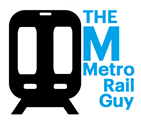Nippon-Arup JV Awarded Versova – Virar – Palghar Sea Link’s DPR Consultant Contract
The winner of another old contract is now known. Back in March, Nippon Koei – Arup India JV was awarded a Rs. 49.99 crore contract to prepare the Detailed Project Report (DPR) of Versova – Virar – Palghar Sea Link in Maharashtra .
The scope of this access-controlled highway’s consultant contract by Mumbai Metropolitan Region Development Authority (MMRDA) includes two components:
- Peer review of 43 km Versova – Virar Sea Link (VVSL) project’s existing DPR. Along with 6 lane connecting roads leading to the western suburbs, the entire project will be 79.11 km long.
- Preparation of a new DPR for extending VVSL to Palghar by approximately 21.8 km. A connection to Palghar town is estimated to be 7.3 km long.
Final Contract Value: Rs. 49,99,54,720 (plus GST)

MMRDA had invited tenders for this consultancy service in November 2023 with an unknown estimate and contract deadline. Technical bids were opened in February 2024 to reveal 2 bidders – Aarvee Associates and Nippon Koei – Arup India JV.
Nippon Koei – Arup India JV’s selection was made on the 80:20 Quality and Cost Based Selection (QCBS) where 80% weightage was assigned to technical score and 20% to financial score. In the technical round, Aarvee scored 87.5 marks, while Nippon – Arup JV scored 98.6 marks.
Financial bids were opened on February 28 to reveal Nippon – Arup JV was also the lowest bidder. Note: Bid values below are inclusive of taxes.
Financial Bid Values
| Firm | Rs. (Crore) |
| Nippon – Arup JV | 56.18 |
| Aarvee Associates | 68.40 |
MMRDA’s Brief Scope: Peer Review of VVSL DPR and Preparation of DPR for an Extension of VVSL from Virar upto Palghar

VVSL project is estimated to cost Rs. 63,426 crore and its extension to Palghar I estimate would be another Rs. 25k – 35k crore.
While Indian cities have a road deficit, admittedly this isn’t a project I’m a major proponent the money can better be used towards under construction mass transit lines (which are crawling) and the development of new lines. I’ve shared some thoughts in the past over here.
For more updates, check out the Bridges section, Expressway section or my Home Page! Sign up for free instant email notifications on new posts over here. Like this post? Get early-access to updates and support the site over here.
– TMRG




Mumbai needs this project, It will be such a breather for daily commuters to use this road. Not everything can be solved by Mass transit commute… I so wish to drive my car to work and avoid these heavy crowded trains & metro…. There will be a freedom to drive anywhere in city
I appreciate your sentiment but sadly you’re wrong.
Read about induced demand.in traffic. A well documented phenomenon arguiing against splurging excessive money on highways, multiple lane roads, etc. They should be the ultimate policy option not the first policy option.
Here is a response generated by chatgpt because it honestly does it better than I would have explained.
Induced demand in the context of traffic refers to the phenomenon where increasing roadway capacity (such as adding more lanes to a highway) leads to a proportional increase in traffic volume, rather than relieving congestion as intended. Essentially, making it easier to drive encourages more people to do so, which eventually brings congestion back to previous levels or even worsens it.
How Induced Demand Works:
Initial Relief: When new lanes are added or roads are expanded, traffic congestion initially decreases, and travel becomes faster and more convenient.
Behavioral Change: The improved conditions incentivize drivers who might have avoided the road during peak times, used alternative routes, or opted for public transportation to now use the expanded road.
Land Use Changes: Over time, the reduced travel time encourages more development and economic activity in areas that were previously less accessible. This can lead to more people moving to these areas, thus generating more traffic.
Return to Congestion: Eventually, the increase in the number of vehicles using the road leads to a return of congestion, often to levels similar to or worse than before the expansion.
Examples:
Urban Highways: Cities that expand highways to alleviate traffic often find that within a few years, the expanded highways are as congested as they were before.
Freeway Expansions: Los Angeles, for example, has repeatedly expanded its freeway system over the decades, but the city remains one of the most congested in the world.
My opinion: Encourage your government to allocate and build more train lines (Harbor line still has 2 lines). Or add more metros.
Or even most cost-effective solution: ask to buy more buses. For 1/10th of 63,000 crore, you can buy 4000-4500 e-buses(current BMC fleet=3,000) that are of highest quality and will cater to millions.
Lastly, read about BRTS(https://en.wikipedia.org/wiki/Bus_rapid_transit) viz. Buses operate in exclusive lanes, avoiding traffic congestion and operate therefore at high speed (because dedicated lines for buses only).
A typical BRTS can cost between $1 million to $15 million per kilometer, depending on the infrastructure requirements.Metro capex can range from $50 million to $300 million per kilometer, depending on whether it is elevated, underground, or at-grade.
Suburban rail costs can vary widely from $10 million to $50 million per kilometer depending on whether it is greenfield or brownfield.
I am writing this because there are many urban planners, policy makers, civil engineers or even future urban planners that may be visiting this site. If I am able to illuminate these things, we may have hope of better shared future.
True, but there’s always negativity about car travel esp in bursting, congested mumbai. Well, instead of a highway out in the open sea, a coastal road similar to the one in south mumbai, would have looked beautiful.
Chutiyo ki foz bhari he yaha….train ki line add karne k badle sea highway bana rahe he…
Whether we build highways or railways, the biggest problem her are-
1. Time of completion – the project gets extended by X years and by that time the benefit disappears due to excess vehicle numbers.
2. Corrupt govt officials and contractors. They pocket money and quality suffers leading to early portholes and 3rd class quality roads.
This can be game changer to de congest mumbai traffics as it will create a suburb.
Any ways palghar is having great potential due to bullet stop and vadhawan port.
Isn’t palghar district a part of Mumbai..?? Mumbai is getting congested and one shud always have a futuristic vision towards solutions..
There is only one Western Highway connecting towns beyond Dahisar for commuting by Road towards Mumbai Thane and to approach the same all these places like Vasai, Virar, palghar, Boisar, Dahanu one needs to burn the fuel for atleast 25kms….
Hence, there is a need for overcoming this problems by constructing alternate connecting roads…
All the infra development does bring in opportunities towrds Housing, Employments, Industrial….growth and helps the economy
These roads shud be infact a priority and implement and constructed asap